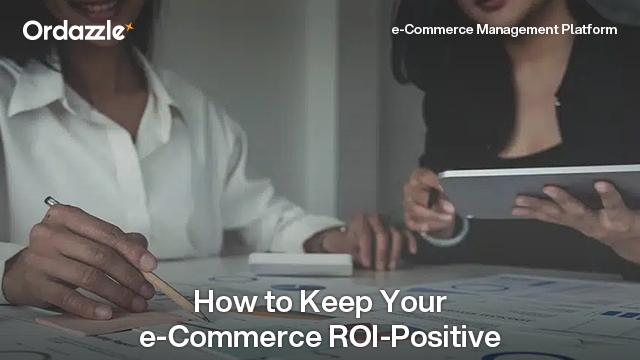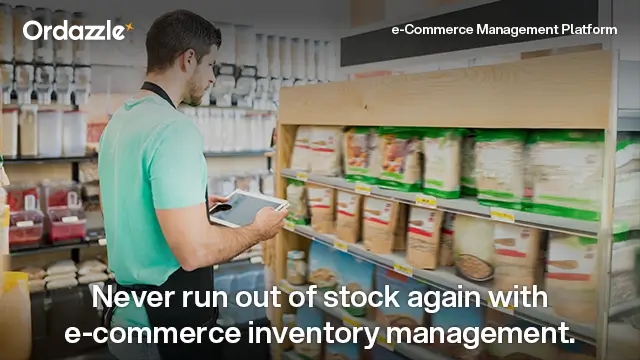How to ensure your e-commerce business is ROI-positive

For any B2C retailer, e-commerce can be a great tool to expand the footprint in the market, reach customers globally, and sell products or services online. However, your business needs to generate a positive return on investment (ROI) to be successful in the long term. In this blog post, we discuss some key strategies for making your e-commerce business ROI-positive.
What does ROI mean in e-commerce?
ROI refers to the ratio of the profit to the investment in the project. It is expressed as a percentage.
If ROI is positive, it implies the investment is generating profit. If ROI is negative, it means revenue from the business is falling short of the investment.
The ROI is inevitably negative when you start a business. Setting up operations requires an initial capital outflow. You need to advertise your products and maybe run a few social media campaigns. You could even try out influencer marketing.
Revenue generation starts only after some time.
Every business owner must aim to become ROI-positive as soon as possible. Thereafter, the objective should be to sustain the momentum and take the ROI higher.
However, one should not stress about it excessively. It can easily take a couple of years before you are in the green.
What is a good ROI in e-commerce?
Aim for high ROI, but stay away from unrealistic targets. You will do well to keep a track of the industry average ROI.
In e-commerce, ROI in the range of 25–50% is considered good.
How is e-commerce ROI calculated?
Return on Investment = [(Income — Investment)/Investment] * 100
Tracking income, to put it simply, is tracking sales from various sources. However, this is easier said than done.
An e-commerce business typically generates sales from two sources: direct and indirect.
Direct sales are those made via websites or marketplaces. A customer visits your website or marketplace, sees your product, likes it, and makes the purchase. It is called direct sales because the customer has directly interacted with your website or marketplace and purchased. It is much easier to measure direct sales and track/monitor these using website analytics tools and e-commerce platforms.
Indirect sales refer to sales via other channels, such as social media, email marketing, or referral marketing. These channels may not directly lead the customer to the website or marketplace, but they can influence the purchase decision. For example, a customer may see an advertisement for a product on social media, and later on, visit the website or marketplace to purchase the product.
Tracking indirect sales is more challenging as it may require additional tools and data analysis to understand the customer’s journey. This is because product consumption is fuelled by content consumption. Customers will click on your digital ads multiple times, browse through your social media content, and visit your website a few times before deciding to buy.
Little wonder then, indirect sales are hard to track. However, by using marketing attribution tools, you can get a better understanding of how different marketing channels are contributing to sales. Platforms such as Facebook, Instagram, and Google come with readymade plugin parameters to facilitate tracking.
Once you’re able to track, you can put a number on your indirect sales as well.
When calculating your e-commerce ROI, include revenue from both direct sales and indirect sales.
How to make sure your e-commerce business is ROI-positive?
Focus on indirect sales
This may sound absurd. Ideally, focus on both direct sales and indirect sales. But when you start off, the chances of getting organic traffic are low. Nobody knows about your brand or what it’s called. How can someone search directly for it?
Focusing on indirect sales will help you leverage your digital advertisements (in terms of placement and optimization) effectively. If you get a regular flow of traffic from digital ads, and if your product is good, this will turn into organic traffic over time.
Some publicity is required when you launch, and inorganic ads can go a long way.
Identify top marketing campaigns
When you start off, you are prone to experiment. This is not just with e-commerce—it is the norm with most start-ups. It is only natural, after all.
How else will you know which marketing strategies are working and which are not?
Make sure you track the progress and results of your individual marketing campaigns. Only through diligent data management and analysis will you be able to figure out which strategies should be adopted and which should be phased out.
Focus on automation and customer assistance
Automation is the way of the future. Of course, robots rolling out orders in a warehouse on a large scale is still not a simple or affordable idea. But certain API automation can go a long way in increasing your turnover. This, in turn, will boost your ROI.
You can also introduce automation in your customer assistance tools. Suggestions, reminders, and strategically placed notifications can have quite an impact on conversion.
Go for an integrated e-commerce management system
Platforms like Ordazzle are designed to address the logistics challenges faced by e-commerce businesses. Using this open end-to-end SaaS system with API integrations, you can access data in real-time and track orders for on-time delivery. It reduces the chance of manual intervention and optimizes e-commerce operations.
Conclusion
Being ROI-positive is critical to the long-term success of any e-commerce business. By understanding your costs and revenue streams, focusing on customer acquisition and retention, and developing a sound marketing strategy, you can optimize your business for profitability. It is important to continuously monitor and analyze your business’s performance to identify areas for improvement and make adjustments as needed.
Achieving positive ROI hinges on effective strategizing, persistence, and the use of intelligent technology. Leveraging the tips outlined in this blog post, you can build a successful e-commerce business that generates solid returns on investment. Remember, running and scaling an e-commerce business is not a simple task, but by staying focused and dedicated, you can achieve your goals and build a profitable business.
Ordazzle helps you streamline your e-commerce processes to drive better efficiencies, sales, and customer experiences across your webstores and the marketplaces where your brand sells. To learn more about the capabilities of Ordazzle, speak to our experts today!


